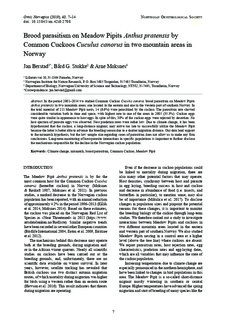| dc.contributor.author | Berstad, Jan | |
| dc.contributor.author | Stokke, Bård Gunnar | |
| dc.contributor.author | Moksnes, Arne | |
| dc.date.accessioned | 2019-09-20T06:34:18Z | |
| dc.date.available | 2019-09-20T06:34:18Z | |
| dc.date.created | 2019-04-12T11:15:19Z | |
| dc.date.issued | 2019 | |
| dc.identifier.citation | Ornis Norvegica. 2019, 42 7-14. | nb_NO |
| dc.identifier.issn | 1892-9737 | |
| dc.identifier.uri | http://hdl.handle.net/11250/2617947 | |
| dc.description.abstract | In the period 2001–2014 we studied Common Cuckoo Cuculus canorus brood parasitism on Meadow Pipits Anthus pratensis in two mountain areas; one located in the eastern and one in the western part of southern Norway. In the total material of 211 Meadow Pipit nests, 14 (6.6%) were parasitized by the cuckoo. The parasitism rate showed considerable variation both in time and space, with highest rate in one of the areas in 2005 (35.3%). Cuckoo eggs were quite similar in appearance to host eggs. In spite of this, 30% of the cuckoo eggs were rejected by desertion. No host ejection of parasite eggs was observed. Nest predation rates were rather low. Due to climate change, it has been hypothesized that the cuckoo, a long-distance migrant, may arrive too late to successfully utilize the Meadow Pipit because the latter is better able to advance the breeding season due to a shorter migration distance. Our data lend support to the mismatch hypothesis, but the low sample size regarding cases of parasitism does not allow us to make any firm conclusions. Long-term monitoring of host-parasite interactions in specific populations is important to further disclose the mechanisms responsible for the decline in the Norwegian cuckoo population. | nb_NO |
| dc.language.iso | eng | nb_NO |
| dc.publisher | The Norwegian Ornithological Society | nb_NO |
| dc.title | Brood parasitism on Meadow Pipits Anthus pratensis by Common Cuckoos Cuculus canorus in two mountain areas in Norway | nb_NO |
| dc.type | Journal article | nb_NO |
| dc.type | Peer reviewed | nb_NO |
| dc.description.version | publishedVersion | nb_NO |
| dc.source.pagenumber | 7-14 | nb_NO |
| dc.source.volume | 42 | nb_NO |
| dc.source.journal | Ornis Norvegica | nb_NO |
| dc.identifier.doi | https://doi.org/10.15845/on.v42i0.2708 | |
| dc.identifier.cristin | 1691915 | |
| dc.description.localcode | The journal is available for all (Open Access), with free access to all published content. Readers may print manuscripts under the same terms as for copying printed documents. This implies that mass copying, or making copies available for commersial purposes, is not allowed without the consent of the author(s). | nb_NO |
| cristin.unitcode | 194,66,10,0 | |
| cristin.unitname | Institutt for biologi | |
| cristin.ispublished | false | |
| cristin.qualitycode | 1 | |
